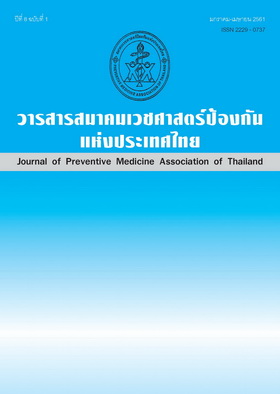Factors Associated with the Outcome of Out-of-Hospital Cardiac Arrest at Emergency Department Phra Nakhon Si Ayutthaya Hospital
Abstract
Cardiac arrest is the most crisis emergency situation. Therefore, the developments and improvements of the resuscitation processes require the précised and completed data. The relevant factors that can improve the effectiveness of CPR process should be clarified. This study aimed to describe a relevant factor to outcome of Out-of-Hospital Cardiac Arrest patients with Cardiopulmonary Resuscitation at Emergency Department Phra Nakhon Si Ayutthaya Hospital. Method: The observational study, in Out-of-Hospital
Cardiac Arrest patients with Cardiopulmonary Resuscitation at Emergency Department Phra Nakhon Si Ayutthaya Hospital between 2016 October, 1 and 2017 September, 30 Result: total 115 persons patient in this study were Male 75.65% and their mean age were 57.62 years. The most common cause of Cardiac Arrest was cardiovascular (54.78%). Most patients were transferred by EMS (49.57%). The witnessed arrests were 78.26%. the estimated time to first chest compression, mostly within 11-30 mins (64.35%). Bystander CPR rate were 2.61%. The initial EKG mostly was non-shock-able rhythm (92.17%). The estimated time to first dose adrenaline mostly was 0-10 min (75.65%). Total CPR time mostly within 11-30 min (46.96%). 45 persons had ROSC (62.61%). There was no factors associated with success in Cardiopulmonary Resuscitation in Out-of-Hospital Cardiac Arrest patients. Therefore, patients who had by stander CPR and who had shockable rhythm that received AED shock had higher rate of ROSC. Therefore, the results of the study should promote bystander CPR and AED at scene to success in Cardiopulmonary Resuscitation in Out-of-Hospital Cardiac Arrest patients.
References
1. สุกิจ วิภูสัตยา, บวร วิทยชำนาญกุล, กรองกาญจน์ สุธรรม. แนวทางปฏิบัติการช่วยฟื้นคืนชีพ 2553. เชียงใหม่. คณะแพทยศาสตร์ มหาวิทยาลัยเชียงใหม่. 2553
2. Sasson C, Rogers MA, Dahl J, Kellermann AL. Predictors of survival from out-of-hospital cardiac arrest: a systematic review and meta-analysis. Circulation Cardiovascular quality and outcomes 2010;3(1):63-81.
3. Eckstein M, Stratton SJ, Chan LS. Cardiac arrest resuscitation evaluation in Los Angeles: CARE-LA. Annals of emergency medicine 2005;45(5):504-9.
4. Skrifvars MB, Saarinen K, Ikola K, Kuisma M. Improved survival after in-hospital cardiac arrest outside critical care areas. Acta anaesthesiologica Scandinavica 2005;49(10):1534-9.
5. Amnuaypattanapon K, Udomsubpayakul U. Evaluation of related factors and the outcome in cardiac arrest resuscitation at Thammasat Emergency Department. Journal of the Medical Association of Thailand = Chotmaihet thangphaet 2010;93 Suppl 7:S26-34.
6. Jacobs I, Nadkarni V, Bahr J, Berg RA, Billi JE, Bossaert L, et al. Cardiac arrest and cardiopulmonary resuscitation outcome reports: update and simplification of the Utstein templates for resuscitation registries. A statement for healthcare professionals from a task force of the international liaison committee on resuscitation (American Heart Association, European Resuscitation Council, Australian Resuscitation Council, New Zealand Resuscitation Council, Heart and Stroke Foundation of Canada, InterAmerican Heart Foundation, Resuscitation Council of Southern Africa). Resuscitation 2004;63(3):233-49.
7. พงศกร อธิกเศวตพฤทธิ์, ยุวเรศ สิทธิชาญบัญชา, รพีพร โรจน์แสงเรือง. การศึกษาผลลัพธ์ของผู้ป่วยหัวใจหยดุเต้นนอกโรงพยาบาลที่ถูกนำส่งห้องฉุกเฉินโรงพยาบาลรามาธิบดี. ธรรมศาสตร์เวชสาร 2551;8(3): 264-273.
8. ธวัช ชาญชญานนท์, ปิยวรรณ สุวรรณวงศ์, ศศิกานต์ นิมมานรัชต์. ผลของการปฏิบัติการช่วยฟื้นคืนชีพและปัจจัยที่มีผลต่อการปฏิบัติการช่วยฟื้นคืนชีพในโรงพยาบาลสงขลานครินทร์. สงขลานครินทร์เวชสาร 2554;29(1):39-49.
9. Haukoos JS, Witt G, Gravitz C, Dean J, Jackson DM, Candlin T, et al. Out-of-hospital cardiac arrest in denver, colorado: epidemiology and outcomes. Academic emergency medicine : official journal of the Society for Academic Emergency Medicine 2010;17(4): 391-8.
10. Elmer J, Polderman KH. Emergency Neurological Life Support: Resuscitation Following Cardiac Arrest. Neurocritical care 2017;27(Suppl 1):134-43.
11. Gilmore CM, Rea TD, Becker LJ, Eisenberg MS. Three-phase model of cardiac arrest: time-dependent benefit of bystander cardiopulmonary resuscitation. The American journal of cardiology 2006;98(4):497-9.
12. Eckstein M, Stratton SJ, Chan LS. Cardiac Arrest Resuscitation Evaluation in Los Angeles: CARE-LA. Annals of emergency medicine 2005;45(5):504-9.
Downloads
Published
How to Cite
Issue
Section
License
บทความที่ลงพิมพ์ในวารสารเวชศาสตร์ป้องกันแห่งประเทศไทย ถือเป็นผลงานวิชาการ งานวิจัย วิเคราะห์ วิจารณ์ เป็นความเห็นส่วนตัวของผู้นิพนธ์ กองบรรณาธิการไม่จำเป็นต้องเห็นด้วยเสมอไปและผู้นิพนธ์จะต้องรับผิดชอบต่อบทความของตนเอง






